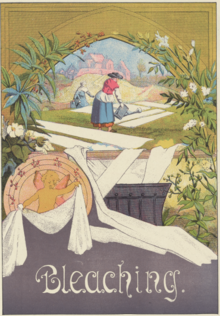
Back Blanquejar els teixits Catalan Bělení textilií Czech Blanqueamiento textil Spanish Tuaradh Irish Textilanyagok fehérítése Hungarian


The textile bleaching (or bleaching of textiles) is one of the steps in the textile manufacturing process. The objective of bleaching is to remove the natural color for the following steps such as dyeing or printing or to achieve full white.[1] All raw textile materials, when they are in natural form, are known as 'greige' material. They have their natural color, odor and impurities that are not suited to clothing materials. Not only the natural impurities will remain in the greige material, but also the add-ons that were made during its cultivation, growth and manufacture in the form of pesticides, fungicides, worm killers, sizes, lubricants, etc. The removal of these natural coloring matters and add-ons during the previous state of manufacturing is called scouring and bleaching.[2]: 193 [3][4][5]
A continuous bleaching range is a set of machines to carry out bleaching action. It consists of several compartments in which fabric moves from one side to another with the help of guide rollers and is treated with chemicals, heated, rinsed, and squeezed. Continuous bleaching is possible for the fabrics in open-width or rope form.[6][7]
- ^ Hummel, J. J. (John James) (1898). The dyeing of textile fabrics. Harvard University. London [etc.] New York, Cassell and company, limited. p. 86.
- ^ Hall, A. J. (Archibald John) (1969). The standard handbook of textiles. New York: Chemical Pub. Co.
- ^ Clark, M. (2011-10-25). Handbook of Textile and Industrial Dyeing: Principles, Processes and Types of Dyes. Elsevier. pp. 65, 66. ISBN 978-0-85709-397-4.
- ^ The Cotton Year Book and Diary. Marsden and Company, Limited. 1919. p. 470.
- ^ "Impurity - an overview | ScienceDirect Topics". www.sciencedirect.com. Retrieved 2021-07-31.
- ^ Code of Federal Regulations: Containing a Codification of Documents of General Applicability and Future Effect as of December 31, 1948, with Ancillaries and Index. Division of the Federal Register, the National Archives. 1992. p. 668.
- ^ BLS Report. U.S. Department of Labor, Bureau of Labor Statistics. 1953. p. 147.